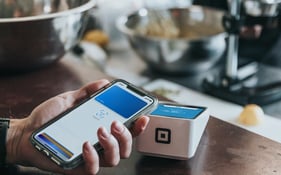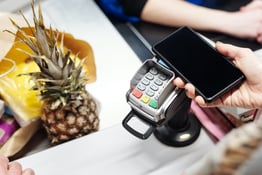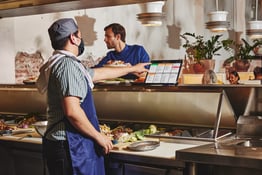Disclaimer: This content is provided for general informational purposes only and is not intended to constitute legal advice. Readers should contact an attorney or advisor for advice specific to their circumstances.
Delivery has become a necessary revenue stream for numerous restaurants, and if you’re operating outside of the fine-dining realm, a solid delivery program is all but expected from customers.
If you’re just getting started, you’ve got two options – partner with a third-party delivery platform or start your own in-house program. That latter option brings significantly more control. But it also requires a larger upfront investment that can drain both time and resources. This is why many restaurants opt to partner with services like DoorDash, Uber Eats, GrubHub, Postmates, Caviar, ChowNow, and/or Seamless. While partnership comes at a fee – often painfully high commission rates – third party delivery services typically enable restaurants to get their delivery program established faster, while handling much of the logistics. They also bring potential to increase your exposure through their existing customer base.
To get started, you’ll need to sign a partnership agreement. Most companies provide a standard formal agreement. While the sales reps might lead you to think otherwise, there’s often room for negotiation here. Regardless, it’s crucial to read through these agreements fully and gain a clear understanding of the prospective commitment.
If you don’t have the time or in-house legal knowledge, consider hiring an attorney to walk you through it. But as a start, we break down some of the big ticket items to be aware of before signing on with a third party platform.
Commission rates
Commission rates charged by third party platforms average anywhere between 15% to 30% per order. It’s a hefty toll for restaurants operating on slim margins, which brings the golden question – are the commission rates negotiable?
“The larger the operation, the more leverage you have, but the commission rates in my experience have absolutely been negotiable,” says attorney Jessica Yeshman, counsel on global technology and outsourcing at Hunton Andrews Kurth. “I don’t think you should shy away from asking just because you’re a smaller operation, especially if you’re bringing volume orders to the platform.”
Yeshman says some providers may ask for volume commitments in exchange for a lower commission rate. This means you’d pledge to fulfill a certain number of orders per month using their platform. “If the operator’s comfortable agreeing to that, I think that’s reasonable to do,” she says.
As Yeshman points out, it’s generally significantly easier to negotiate when you’re a multi-unit operation with the capability to draw mass customers to the platform. But regardless, it’s always worth trying. Don’t let provider reps intimidate or deter you from bringing up the conversation. They know you’re likely shopping around, and it’s smart to be direct about what you’re seeking in the short- and long-term.
Insurance requirements
Many of the big players have certain insurance requirements. It’s important to weigh this into your costs, since you may have to adjust your current policy.
“DoorDash, for instance, requires a pretty reasonable $1 million dollars per-occurrence [general liability insurance policy], $5 million in the aggregate,” says Michael Laszlo, attorney and partner at LaszloLaw. “But some people won’t have those limits, and you’d have to buy those limits or you’d be in breach of the contract.”
These days, cyber liability insurance is often required, too, which covers your business from incidents like data breaches, including those involving sensitive customer information, such as credit card numbers.
“Cybersecurity is a big deal right now, with phishing scams and hackers, and I’d say you want cybersecurity insurance anyway. That’s the safest way to operate your business, but I’m sure a lot of my clients don't have it,” says Laszlo. “It can be expensive and not all the insurance carriers underwrite it, so you may have to go out and buy a special policy.”
Review your current insurance policy before signing onto any agreements and make sure any additions are within your budget. If a delivery incident happens, and your insurance doesn’t meet the requirements, the financial repercussions could be serious.
Arbitration rules
Many agreements call for arbitration, or the use of an officially appointed third party to settle disputes outside of court. When possible, opt out, says Laszlo.
“The process is much stickier to get going – you have to make a demand on the other party, and they generally have 30 days to respond, and if they don’t respond, you have to convince a private arbiter to take the case,” he says. “Whereas, if I can just go to the courthouse and file a lawsuit, the other side’s in, there’s no way around it.”
Termination provisions
With most platforms, you’ll be committing to a minimum one-year partnership. But not all restaurants can manage to make the margins they need, and sometimes that calls for terminating an agreement early.
“It’s not like you’re just trying this out – you’re signing, with some clauses as to when and where you can terminate, and you have to be aware of that and all of the associated fees,” says Laszlo.
Think through the worst case scenario, and try to ensure you’ll be able to comply with the termination rules.
“You may want to ask for the right to terminate the contract for convenience, which is for any reason or no reason at all, or if they’ve breached certain important provisions of the agreement,” says Yeshman, noting that while not all vendors will agree to that, again, there’s no harm in asking.
Transparency of responsibilities between restaurants, delivery platforms, and drivers
Ideally, your partnership agreement should put into writing which party is responsible for each part of the delivery process. For example, if a customer complains, is it going to be Caviar or the operator who responds? If a driver delivers to the wrong house, does that fall back on Caviar or the restaurant or neither?
“Some providers may be a little more lenient than others,” says Yeshman. “But if you have an agreement that accurately and narrowly defines each party’s responsibilities, it will help prevent courts and customers from implying an agency relationship between either the provider and driver, or the provider and the restaurant.”
An agency relationship is a fiduciary relationship between two parties where one party expressly or impliedly authorizes the other party to act under their control and on their behalf. This can notably cause murky waters when it comes to restaurants and delivery drivers.
“If there’s an agency relationship that’s inferred due to the rest of the operators' interactions with drivers, [the operator] could potentially be liable for the driver’s acts or omissions,” says Yeshman.
For example, if a driver assaults a customer, the restaurant could potentially be liable to the customer for that driver’s acts.
“This isn't totally well established in the courts yet, but most of the delivery providers take the position that the drivers are independent contractors, and so I would highly suggest that the operators try to limit that implication that there's some sort of agency relationship, if possible,” says Yeshman.
Protection against IP infringement cases
If you’re using Uber Eats, and another company comes to you and says, “Your use of that platform infringes my intellectual property rights,” you want to be protected. Sound like an unlikely scenario?
“It happens all the time,” says Yeshman. “These delivery platforms provide software or technology to the restaurant, and so at a minimum, you want an IP infringement indemnity from the provider.”
An indemnity is essentially financial protection for you as the operator. In this case, it means that if someone comes after you claiming you’re using technology that they say infringes on their intellectual property rights, Uber Eats, for example, will defend you and pay any damages awarded that may arise out of that claim. If you don’t have an indemnity from Uber Eats, you’d be responsible for responding to the claim, defending against it, and paying any resulting damages.
“Even though the provider is just giving the restaurant the platform, and the restaurant isn't doing anything with it other than using it, the [plaintiff] is going to sue UberEATS, and all of their users using the technology,” explains Yeshman. “They’re going to bring everyone who has pockets into the claim, and they're going to hope that something sticks.”
Equal liability cap
A liability cap is an agreement within the contract that limits the amount of money either party can get if one party breaches the agreement. Most provider contracts are written so that there’s a liability cap that only applies to the provider, and the restaurant is then subject to unlimited liability, says Yeshman.
Let’s look at a hypothetical example where the cap doesn’t apply to both parties. Let’s say Caviar isn’t providing as many drivers as it agreed to. This is causing customers to complain and your restaurant to take a financial hit, so you place a breach of warranty claim against Caviar. The liability cap in your agreement is unilateral in favor of Caviar and is equal to $50,000, meaning Caviar will never have to pay more than $50,000 for damages. But your damages are $200,000. In this case, you can recover $50,000 but have to eat the other $150,000. Meanwhile, two weeks later, Caviar goes off and places a separate claim against your restaurant for $500,000, and they win the case. You’d have to pay the full $500,000 because the liability cap in your agreement only applied to Caviar, meaning you’re stuck with unlimited liability. It doesn’t sound all that fair, right?
In reality, it isn’t very common for a third party delivery platform to sue a restaurant – it’s bad for PR reasons. But it can happen, and you want to make sure you get an even deal from the start. This means fighting so that you and the provider receive the same liability cap.
“The liability cap should generally be tied closely with how much money the restaurant is spending under the agreement,” says Yeshman. This requires you to estimate the number of orders you expect to process with the provider annually and multiply that by the agreed commission rate.
Indirect consequential damages waived for both parties
Just like with the liability cap, you want to make sure that your agreement waives indirect consequential damages for both the delivery service provider and you. This means that neither party can recover those types of damages against the other. But what exactly is an indirect consequential damage?
“Please note that there’s no bright line rule on how courts categorize different types of damages – [it’s] a highly fact specific analysis,” says Yeshman.
But in general, says Yeshman, indirect and consequential damages are “damages that are not foreseeable” – damages you could’ve never predicted or intended. Consult with an attorney for specific examples.
If indirect consequential damages are only waived for the third party provider, in the event that you breach the agreement, the provider could potentially recover all damages, foreseeable or not, it has against you. In other words, this kind of agreement expands your potential liability to include factors often outside of your control.
“You want it to be mutually in favor of both the restaurant and the provider so that neither party is stuck footing the bill for unforeseeable damages,” says Yeshman.
Grace Dickinson is a reporter at Back of House. Send tips or inquiries to grace@backofhouse.io.
[Photo courtesy Pavel Danilyuk]





